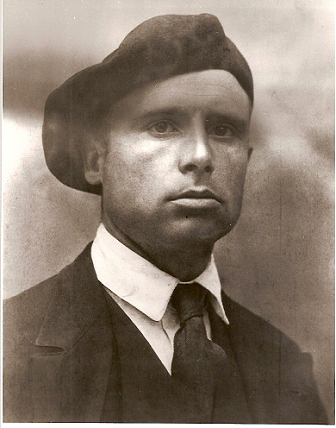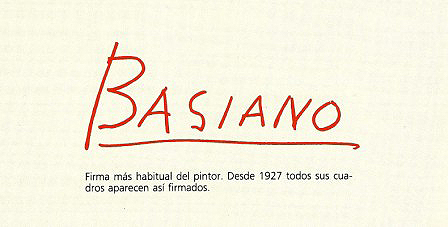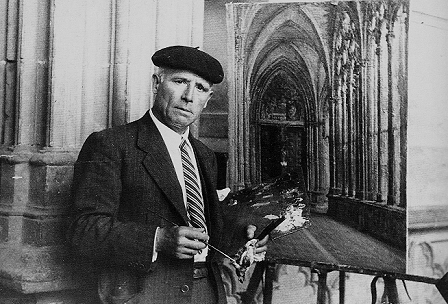The piece of the month of January 2016
"CHAPEL OF LAS NAVAS. CATHEDRAL OF PAMPLONA", WORK BY JESÚS BASIANO.
José Mª Muruzábal del Solar
Ph.D. in Art History
If there is a name that is especially well known among the Navarrese painters of the Contemporary Age, it is that of Jesús Basiano. In him coincide a series of circumstances, of very varied nature, that have ended up placing him among the most popular Navarrese painters of the 20th century. His personality and his work, especially those remembered landscapes that capture each and every corner of Navarre's geography, are deeply rooted in the feelings and essence of our people. If a survey was carried out in the streets of Pamplona asking for the name of a Navarrese painter, it is not difficult to imagine which one would get the vast majority of the answers, Jesús Basiano. It is, in final, as Ollara and José María Iribarren pointed out at the time, or as the magnificent monograph dedicated to the painter and published by the Caja de Ahorros Municipal de Pamplona, "BASIANO, EL PINTOR DE NAVARRA" (BASIANO, THE PAINTER OF NAVARRA) is titled.
Jesús Basiano (Murchante, 1889 - Pamplona, 1966) was born in the riverside town of Murchante; he spent his childhood and youth in Bilbao, where his family moved for business reasons. He studied in Arts and Crafts in Bilbao, San Fernando in Madrid and in Rome. For all these reasons it is evident that he had a very careful training for his time. Between 1917 and 1925 he settled in Durango, where he rubbed shoulders with the most important Basque painters of the time and met Darío de Regoyos. This Durango period is among the best of his production; in the words of Llano Gorostiza, it is the period of the "Durangués de Murchante".

Portrait of Jesus Basiano during his time in Durango.
In 1926 he settled in Pamplona, from where he would not move for 50 years. He painted, without rest, for more than sixty years, an enormous production of many thousands of paintings. He traveled the varied landscapes of Navarre, all its corners, on foot, by bicycle or in his famous biscuter; from the fifties accompanied by his sons Jaime and Javier, who inherited the official document of his father. He held countless exhibitions in Madrid and Barcelona, Bilbao and Sebastian, Zaragoza and Vitoria and, of course, Pamplona, where we remember the 1955 and the anthology of 1965, both in the conference room of García Castañón in Pamplona. Among his many awards we highlight the Diploma of Honor, of First class, at the exhibition International Barcelona in 1929, for the painting Tejados y Torres de San Cernin; and the Third Medal at the exhibition National Fine Arts in 1943.

The decade of the fifties was the zenith of his popularity in Navarra. The year 1951 will be a basic milestone in his biography thanks to the heartfelt and popular tribute that his hometown, Murchante, offered him. The journalistic chronicles of the time explain in detail the acts, organized by the town council of the locality, presided by Mr. Martínez Pardo. He was named favorite son of the town, a tombstone was unveiled in his birthplace and the event concluded with a tribute banquet that received many supporters from inside and outside Navarre. These were also the years of the Hispano-American Exhibitions and the period of the construction of the Yesa reservoir. Our artist painted countless pictures in the area, including a fresco in the new parish of the town of Yesa, with the topic of San Virila de Leyre. On March 23, 1966, he died suddenly, at his home in the San Juan neighborhood of Pamplona, at the age of 77. His death was greatly felt throughout Navarre as he was a beloved and popular figure. His obituary was reported by all the press of the time. Among all of them, it is worth mentioning the heartfelt article written in Diario de Navarra by his friend Ollarra.

Jesús Basiano painting in the cathedral of Pamplona in 1955.
The painting we present here (oil on panel, 50 x cm. 1940. graduate and dated in pencil on the back) is kept in a well-known collection of Navarrese art. It was included in the exhibition Artistas navarros en una colección de arte navarro, in the conference room Conde Rodezno in Pamplona (November 2013 to January 2014). It is also reproduced in the 2014 report of the Chair of Heritage and Navarrese Art, under the University of Navarra The work of Jesus Basiano is initially defined with a simple concept, realism. The fundamental basis on which his painting is based is what the artist captures and feels in the landscape. It is a representation with the closest possible approximation to the model. This is a sincere and honest painter. He felt the need to capture a given landscape, as it is seen, without adding or removing elements. Nature and landscape are sufficiently beautiful for the artist to have to resort to strange artifices. His work is based on the masters of impressionism to move towards an expressionist realism, staff and vital.
Chapel of Las Navas. Cathedral of Pamplona, by Jesús Basiano, 1940
Oil on panel, 50 x cm.
Private collection
In the varied subject matter of Basiano's works, the paintings of the cathedral of Pamplona and its exceptional cloister stand out. The examples are abundant and of quality B, presenting those harmonious galleries, the bold ogives, its famous portals. They are, in short, the ideal embodiment of the interior tranquility, peace and spiritual reflection that exists there. These works demonstrate a perfect mastery of drawing and a marvelous capture of the lights and chromatic varieties that are enclosed there. The colors and their tonalities are in nature, in the countryside, everywhere. Basiano's aim was to capture them and transfer them to the canvas. This, which initially seems simple, was the secret of his production. Those who know oil painting know perfectly well how difficult it is to use the precise color, to find the right tonality for each status, to see the infinite ranges that appear within the same color. Basiano possessed the rare skill of mastering these capacities, of understanding color marvelously. He always interpreted the subjects by the sense of color. It was based on the optimism that was born from the contemplation of the landscape and the vital need to transfer those colors to his work. He had an exceptional retina that captured color ranges everywhere, where other artists only saw a few. This Chapel of Las Navas, in the cathedral cloister of Pamplona, is a magnificent example of all this.
bibliography
-MURUZÁBAL DEL SOLAR, J. M., Basiano, el pintor de Navarra, Pamplona, CAMP, 1989.
-MURUZÁBAL DEL SOLAR, J. M., "Basiano, el pintor de Navarra", in Revista Antiqvaria, nº 63, 1989.
-MURUZÁBAL DEL SOLAR, J. M., "Jesús Basiano y la pintura vasca", in notebook de artes plásticas y monumentales, nº 5, Eusko Ikaskuntza, 1988.
-MURUZÁBAL DEL SOLAR, J. M., "Basiano, el pintor de Navarra", in Diario de Navarra, December 9, 1989.
-MURUZÁBAL DEL SOLAR, J. M., "Basiano, el pintor de Navarra", in Catalog exhibition anthology, in conference room de Castillo de Maya de Pamplona, CAN, 2004.
